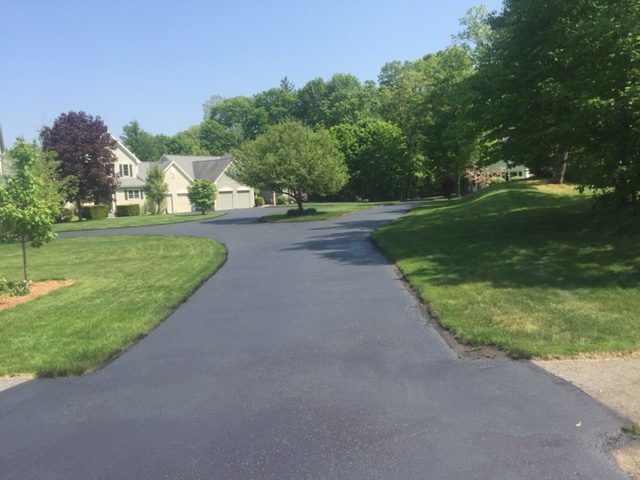Protect Surface Areas with Professional Asphalt Sealing: Cold Mix Essentials
Cold Mix Asphalt Vs. Hot Mix Asphalt: Which Is Right for You?

Structure Distinctions
Cold mix and warm mix asphalts differ significantly in their structure, with unique characteristics that affect their efficiency and applications. Cold mix asphalt is generated by emulsifying the asphalt binder with water and an emulsifying representative prior to mixing it with aggregate. This approach enables for the asphalt to be convenient at reduced temperature levels, making it excellent for momentary repair work and for use in chillier weather condition problems. Hot mix asphalt, on the other hand, is made at high temperatures, usually in between 300-350 ° F, which aids to attain better compaction and a much more durable final item. The warm mix asphalt production process involves heating the aggregate and asphalt binder separately before integrating them at the asphalt plant.
In addition, chilly mix asphalt has a tendency to be much less dense and a lot more flexible than warm mix asphalt. This adaptability makes it much better matched for locations with greater levels of motion, such as driveways or roads with hefty traffic. On the other hand, warm mix asphalt is known for its high resilience and resistance to rutting and breaking, making it a recommended option for highways and high-traffic roadways where durability is critical.
Installation Refine Differences
The procedure of mounting chilly mix and hot mix asphalt exhibits noteworthy differences in their needs and procedures. Cold mix asphalt, being a much more adaptable material, can be used directly from the bag or container onto the gap or damaged area. It needs marginal preparation job, such as cleaning up the location and condensing the cool blend with hand devices. This makes it a hassle-free choice for temporary and quick repairs. In contrast, warm mix asphalt requires a much more elaborate installation process. It includes heating up the mix to heats before laying it down on an effectively prepared base. The preparation includes compacting the base, applying a tack coat, and utilizing heavy equipment like pavers and compactors for a sturdy and smooth coating. Because of the home heating demands, warm mix asphalt installments are generally accomplished by experts with specific tools, ensuring a more structurally audio and permanent result.
Resilience and Durability Variables
When taking into consideration asphalt options, resilience and durability are vital aspects to review for lasting sidewalk efficiency,. Hot mix asphalt (HMA) is known for its outstanding sturdiness and long life. The high temperature levels during the mixing and laying procedure permit far better compaction, causing a denser and more powerful sidewalk framework. This results in HMA being a lot more immune to rush hour lots, harsh climate condition, and the impacts of maturing contrasted to cold mix asphalt (CMA)
In regards to longevity, HMA commonly exceeds CMA as a result of its superior strength and resistance buildings. HMA sidewalks have a longer solution life, calling for less frequent repair services and upkeep, which can convert to cost financial savings over time. Additionally, HMA pavements are extra quickly customizable to satisfy specific job demands, better improving their durability.
Expense Factors To Consider
Considering the monetary effects is a critical facet when evaluating the selection in between hot mix asphalt (HMA) and cold mix asphalt (CMA) for pavement jobs. While the preliminary price of hot mix asphalt is commonly higher than that go now of cool mix asphalt, HMA typically provides a much more economical remedy in the long run due asphalt repair to its remarkable resilience and long life.
In enhancement to material expenses, it's necessary to consider the costs connected with installment and maintenance when contrasting HMA and CMA. HMA generally calls for specialized equipment and experienced labor for appropriate installation, which can impact overall task costs. Conversely, CMA is easier to collaborate with and can usually be used making use of simpler methods, possibly decreasing setup expenditures. Ultimately, the choice between HMA and CMA need to take into consideration not just the first price but additionally the long-term monetary implications to figure out one of the most economical choice for the details sidewalk project.
Environmental Impact Contrast
Comparison of the environmental influences between warm mix asphalt (HMA) and cool mix asphalt (CMA) discloses distinct differences in sustainability methods. HMA manufacturing calls for high temperatures, leading to increased energy intake and greenhouse gas discharges.
Moreover, the use of CMA commonly involves reusing existing asphalt sidewalk, promoting source conservation and reducing the amount of waste sent to landfills. By opting for CMA over HMA, road construction tasks can add favorably to ecological conservation initiatives.
Verdict
Finally, the choice between cool mix asphalt (CMA) and hot mix asphalt (HMA) relies on various aspects such as structure, installment procedure, durability, longevity, cost, and ecological influence. asphalt patch repair. While CMA provides a cost-effective and quick remedy for small repair services, HMA ensures superior resilience and durability for heavy web traffic areas. Consider these aspects carefully to figure out which sort of asphalt is the ideal option for your paving needs

Considering the monetary effects is a crucial element when reviewing the selection in between hot mix asphalt (HMA) and cool mix asphalt go now (CMA) for pavement projects. While the preliminary price of warm mix asphalt is typically greater than that of chilly mix asphalt, HMA usually supplies a more affordable remedy in the long run due to its premium longevity and longevity. asphalt patch repair.Comparison of the environmental impacts between hot mix asphalt (HMA) and chilly mix asphalt (CMA) reveals unique differences in sustainability methods.In conclusion, the selection between cold mix asphalt (CMA) and warm mix asphalt (HMA) depends on various elements such as structure, setup process, longevity, longevity, cost, and ecological impact